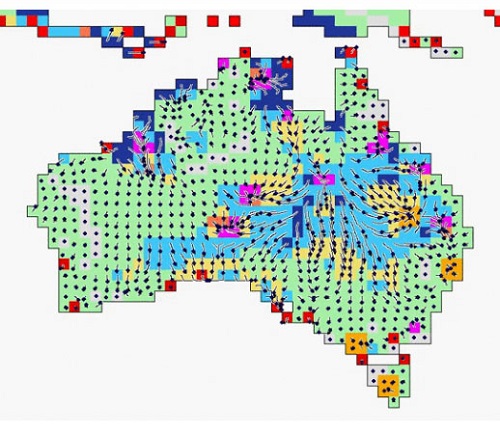
1. Pacific winds slow global warming
A team of Australian scientists has found that stronger winds in the Pacific are slowing global warming (paper here, paywalled).
The study found that the winds were churning the Pacific like a washing machine, bringing the deeper colder water to the surface and pushing the warmer water below.
Scientists do not expect the effect to last. Matthew England of the University of New South Wales:
“The phase we’re in of accelerated trade winds particularly lasts a couple of decades,” Professor England said.
“We’re about 12 to 13 years in to the most accelerated part of the wind field.”
There’s more at The Conversation, at Open Mind plus Matthew England at RealClimate and Mike Mann at Huff Post.
The heat is only at a depth of 100 to 300m, so may easily become available to the atmosphere again. Mike Mann thinks the winds and the La Niña effect may be the result of global warming.
2. Animals and plants on the move
The CSIRO have developed a fascinating map showing species on the move due to climate change. I’ve done a screenshot here, but the animated version in the link is best:

Blue areas indicate significant change and pink areas show “corridors” where animals and plants may be able to move through to more favourable conditions.
“Sink” areas, in orange, show where the movement of land-based species is likely to hit a dead end, by reaching a coastline or mountain range.
Something strange is happening in the middle of Queensland.
3. The year’s weather in 8 minutes
Gareth at Hot Topic has posted a live map of the weather for 2013 as seen from weather satellites. I recommend using the full screen button.
It’s interesting not so much for 2013, but as an overview of how the global system works.
4. Half new energy is green
Fully 44% of all generating capacity installed last year around the world was renewable, says the latest UNEP Global Trends in Renewable Energy Investment, despite a 14% decline in renewables investment, and in new electricity generally.
Europe has cut investment in renewables by 44%. China now leads with $56 billion invested last year.
Shares in clean energy companies rose 54% last year.
5. Germany turns to brown coal
Germany has more wind turbines and solar panels than any other industrialised country, but it also burns more brown coal (lignite) than any other.
As Germany turns off its nuclear power, gas is expensive and a third of it comes from Russia. In these circumstances Germany is turning to lignite to solve the intermittency problem. Because lignite takes 8 hours to fire up plants are run at 40% whether needed or not.
There are three options:
- storage systems, such as pumped water or hydrogen
- improving and extending electricity grids so that surpluses can be moved to areas of need
- organising tariffs to manage demand from big energy users that have intermittent demand.
None of these is being implemented so far to the extent that makes a real difference.
6. Energy use in UK and Germany
Germany generates considerably more energy than the UK, even when population is taken into account.
This graph shows the source of Germany’s power generation for the first quarter of 2014:

Nuclear, being phased out over a decade, is a considerable source. Biomass is larger than gas.
Renewable energy is expected to be the main source of electricity generation in Germany by 2030, but policy in both countries is a concern:
In the UK, the Conservative party has recently announced that it will put a cap on onshore wind expansion if it gets into power in 2015. Subsidies for solar power are also likely to be cut, according to media reports – suggesting that Conservatives are increasingly hostile to plans to expand renewables.
In Germany, the government’s putting in place a new renewables plan – possibly in response to concern about rising energy prices. The new rules mean from 2017 energy providers will no longer get guaranteed prices for their power, according to media reports. The effects are unclear, but could slow the growth of German green energy.
7. But then, in Germany at least…
…energy policy is very complex.
In Germany governments attempt to control markets, it seems.
Germany’s energy transition – the Energiewende – has largely been a bottom-up grassroots movement over the past 25 years. Citizens and energy cooperatives account for roughly half the investments. Large utilities are only just now getting on board.
Current changes in policy are aimed at tipping the balance back towards the large corporates, while keeping renewable energy development on track. Policy is also favouring offshore rather than onshore wind.
The article mentions that discussion will now turn to “capacity payments”. I suspect such payments will be necessary to provide backup capacity for intermittency problems, especially if weather forecasts are wrong. For continuity of supply the corporates may have to be paid for unused reserve capacity.
Reminder: Use this thread as an open thread on climate change.

 Recently my wife and I saw an item on the TV about the
Recently my wife and I saw an item on the TV about the 

